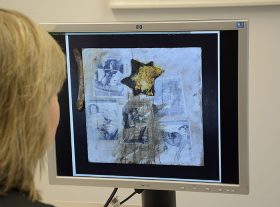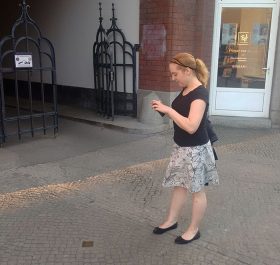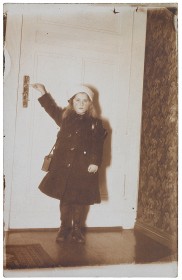
Nina Wilkens contemplating the collage “Found objects on flat cardboard box” on her computer screen; Jewish Museum Berlin, photo: Svenja Kutscher
Five black and white photographs of a scantily-clad woman, legs spread open, in various suggestive poses. The pictures smudged and stuck askew onto white cardboard. On top, a Star of David partly smeared with yellow paint. A brown dildo is fastened next to the cardboard. This constellation of things looks at first glance like useless trash. Objects left on the ground, covered with their share of grime, and now lying here piled on top of one another. This work by Boris Lurie from our current exhibition “No Compromises! The Art of Boris Lurie” (further information about the exhibition on our website) has no name and its date is ambiguous.
When I started thinking, around a year ago, about a pedagogical program on Boris Lurie, I got stuck on this picture as I sat at my computer clicking through images of the works that were being considered for the exhibit. I was confused by my own reaction to this collage of two- and three-dimensional objects: vacillating between disgust and uncertainty. I had the words “obscene” and “tasteless” on the tip of my tongue but found them unsuitable. The image hurt. I wondered how students would react to Boris Lurie’s art. → continue reading
Our Project on the Topography of Jewish Life in Germany

Stumbling stone in remembrance of Editha Machol in Yorkstraße 88 in Berlin-Kreuzberg; Jewish Museum Berlin
“I was playing Hans-Jürgen for you again,” my father said gleefully when he called me over Whit Weekend. Hans-Jürgen is 68, a retired teacher, and interested in regional Jewish history. My father, however, is not a retired teacher and his name is actually Rudi, but he had displayed what one could call Hans-Jürgenesque behavior: he participated in a public tour of a Jewish cemetery in his hometown, recorded his impressions with a camera, and sent them to us in Berlin. For Hans-Jürgen doesn’t really exist: he’s just a fictitious person we used in order to develop a prototype – a kind of pre-testing version – for a cartographic app. This prototype is the foundation for the online portal, which we at the Jewish Museum Berlin want to complete construction on in the next two years. The goal is to gather – all in one place, for the first time – comprehensive geographical information on Jewish life in Germany and make it accessible online in an interactive map. → continue reading
A Photo Collection Found Hiding in Berlin-Friedrichshain

A girl standing in front of a door, presumably Berlin, about 1918–1922; Jewish Museum Berlin
Every time I open a new folder of photos, I can’t know what’s waiting for me – what faces I’ll find or fates will be revealed. Images are often part of a larger collection, consisting of documents, everyday articles and artwork, for which we already know the biographies of those pictured or can further research. Such was the case, for example, of the cabaret artist, Olga Irén Fröhlich, whom I’ve written about before on this blog. This time, however, the people in the photographs will remain unknown to me; I won’t be able to attach names or histories to them. Perhaps you can!
It’s not out of the ordinary to work with collections that have been in the Museum’s possession for decades. → continue reading


